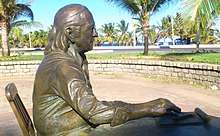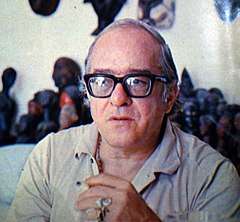Vinicius de Moraes
| Vinícius de Moraes | |
|---|---|
|
Vinícius de Moraes in Paris, 1970. | |
| Born |
Marcus Vinicius da Cruz e Mello Moraes 19 October 1913 Rio de Janeiro, Brazil |
| Died |
9 July 1980 (aged 66) Rio de Janeiro, Brazil |
| Pen name | "O Poetinha" |
| Occupation | |
| Nationality | Brazilian |
| Alma mater | Rio de Janeiro State University |
| Literary movement | Modernism |
Marcus Vinicius da Cruz e Mello Moraes[1] (October 19, 1913 – July 9, 1980), also known as Vinícius de Moraes[note 1] (Portuguese pronunciation: [viˈnisjuʃ dʒi moˈɾajʃ]) and nicknamed O Poetinha ("The little poet"), was a Brazilian poet, lyricist, essayist and playwright who became a seminal figure in modern Brazilian music and literature. He served as a national diplomat, composed his own bossa nova music and, as an interpreter of his own lyrics, recorded several significant albums.
Early life

He was born in Gavea, a suburb of Rio de Janeiro, to Clodoaldo da Silva Pereira Moraes, a public servant, and Lidia Cruz, a housewife and amateur pianist. In 1916 his family moved to Botafogo, where he attended Afranio Peixoto Primary School. He gained entrance to a Masonic lodge in 1920 through his maternal grandfather. Fleeing the 18 of the Copacabana Fort revolt, his parents moved to Governador Island while Moraes remained at his grandfather's home in Botafogo to finish school. He saw his parents on weekends and holidays. During these visits, he became acquainted with composer Bororo.
Beginning in 1924, he attended St. Ignatius, a Jesuit high school where he sang in the choir and wrote theatrical sketches. Three years later, he became friends with the brothers Paulo and Haroldo Tapajos, with whom he wrote his first musical compositions, which were performed at friends' parties. In 1929 he completed high school and his family moved back to Gavea.[2] During the same year, he was admitted to the Faculty of Law at the University of Rio de Janeiro (UERJ). At the "School of Catete", he became friends with essayist and future novelist Octavio de Faria, an activist integrist Catholic and leader of a group of right-wing Catholics organized around Centro Dom Vital, a think-tank created by intellectual Jackson de Figueiredo[3] shortly before his death.
Faria encouraged Moraes's literary vocation, turning him into a kind of right-wing fellow traveler. Moraes received his college degree in Legal and Social Sciences in 1933. Soon after, he published his first two collections of poetry: Caminho Para a Distancia ("Path into Distance") (1933) and Forma e Exegese ("Form and Exegesis"). Both collections were composed and published under Octavio de Faria's informal editorship. The collections were symbolist poetry concerned with Catholic mysticism and the search for redemption against sexual seduction.[4]
In the essay "Two Poets" (1935), Faria compared Moraes's poetry to that of Augusto Frederico Schmidt.[5] The tension between Faria and Moraes' mutual Catholic activism and Faria's homosexual attraction toward Moraes limited their friendship. Faria attempted suicide because of his unrequited love for Moraes.[6] Despite their estrangement, Moraes wrote two sonnets, the first in 1939 ("Sonnet to Octavio de Faria"), the second during the 1960s ("Octavio") in ambivalent praise of his friend.[7]
In 1936, Moraes got the job of film censor for the Ministry of Education and Health. Two years later, he won a British Council fellowship to study English language and literature at Oxford University. He abandoned his use of blank verse and free verse in favor of the sonnet, both the Italian form used in Portuguese poetry (two quatrains, two tercets) and the English form (three quatrains and a couplet).[8] He was considered one of the most prominent of the "generation of '45", a group of Brazilian writers in the 1930s and 1940s who rejected early modernism in favor of traditional forms and vocabulary.[9] He is usually equated with his friend Joao Cabral de Melo Neto for the high technical skill of their poetry.[10] However, if in Cabral's works technique served the depiction of objective reality, in Moraes's work technique served the depiction of the subjective mood of sexual love.[11] The basic meter in Moraes's love poetry is the decasyllable, taken mostly from Camoes' lyrical poetry.[12]
During his stay in England, Moraes wrote the verse collection "Novos Poemas" ("New Poetry"). He was married (by proxy) to Beatriz Azevedo de Mello, with whom he had two children: filmmaker Suzana de Moraes and Pedro. In 1941, he returned to Brazil and worked as a film critic for the newspaper A Manha ("The Morning."), as a contributor to the literary journal Clima ("Climate"), and at the Banking Employees' Institute of Social Security, the public pension fund for workers in banking institutions.
During the following year, he failed the admission test for a diplomatic career at the Ministry of Foreign Affairs (MRE). Shortly after, he was commissioned to accompany American writer Waldo Frank, a literary acquaintance, on tour across Northern Brazil. In Moraes's words, it was contact with both Frank and "appalling poverty" that turned him into "a man of the Left".[13]
Moraes passed the MRE admission test on his second attempt in 1943. He was given the job of vice consul in Los Angeles. He published a book of poems, Cinco Elegias ("Five Elegies"), followed by Poemas, Sonetos e Baladas ("Poems, Sonnets and Ballads"). After his father died in 1950, he went to Brazil, then returned and published two more books: Livro de Sonetos ("Book of Sonnets") and Novos Poemas II ("New Poems II"). During the 1950s, he worked for the Brazilian consular service in Paris and Rome. He often visited historian Sergio Buarque de Holanda, who was teaching in Italy as a visiting scholar.

In 1951, Moraes married his second wife, Lila Maria Esquerdo e Boscoli. He wrote film reviews for Samuel Wainer's Vargoist paper Ultima Hora. He was named a delegate to Punta del Este film festival and was given a commission to study the management of film festivals at Cannes, Berlin, Locarno and Venice in view of the forthcoming São Paulo Cinema Festival, as part of the commemoration for the city's 400th anniversary.[14]
In 1953 his third child, Georgiana, was born. A fourth child by his second wife was born in 1956. He went to Paris as second secretary at the Brazilian embassy in France. He released his first samba, Quando tu passas por mim ("When You Pass By") which was composed with Antonio Maria. During the next year, he wrote lyrics to chamber music pieces by Claudio Santoro. He became a well-known playwright with the staging of his musical Orfeu da Conceicao (Black Orpheus) in 1956. He met pianist Tom Jobim, who was commissioned to write music for the play. Jobim wrote "Se Todos Fossem Iguais a Voce", "Um Nome de Mulher" and other songs included in the production. The play was staged in 1956 in São Paulo and Rio de Janeiro, having its text published in a deluxe edition illustrated by Carlos Scliar. At the end of 1956, Moraes returned to France, having been transferred in 1957 from the Brazilian Embassy to the Brazilian representation at UNESCO. In 1958 he was transferred to the Brazilian embassy in Montevideo, returning to Brazil in transit. While in Brazil, he married his third wife, Maria Lucia Proenca.[1]
Bossa nova
In 1958, the singer Elizete Cardoso released her album Canção do Amor Demais, marking the beginning of bossa nova. This record consists wholly of compositions by the Jobim-Vinícius partnership, or by either of the two (Canção do Amor Demais, Luciana, Estrada Branca, Chega de Saudade, Outra Vez...). The recording also featured a relatively unknown João Gilberto on two tracks. With the release of this record, Vinícius' career in music (as well as that of many involved with him) may be said to have truly begun.
The songs of Jobim and Vinícius were recorded by numerous Brazilian singers and performers of that time. Renditions of many Jobim-Vinícius' numbers on João Gilberto's first, second and third albums would firmly establish the sound and the core repertory of the bossa nova and would influence a new generation of singers and songwriters especially in Rio de Janeiro. Among these songs are all time hits such as Garota de Ipanema, Insensatez and Chega de Saudade. In August 1962, Vinícius would for the first time perform publicly as singer and entertainer - together with Jobim and Gilberto - at the Rio nightclub Au Bon Gourmet. This was to be the first of his pocket-shows, i.e., performances made to small audiences where he would present future international hits - such as the aforementioned Garota de Ipanema as well as Samba da Benção. Vinícius would also introduce promising new singers at the time, such as Nara Leão. He wasn't a natural singer, with a flat, nasal baritone voice, but he generally had singers singing harmony or background to sweeten the sound.
That first spree as entertainer would end in 1963, as Vinícius returned to his post in the Brazilian representation at UNESCO after his fourth marriage to Nelita Abreu Rocha.[1]
Cinema recognition and collaborations
His play Orfeu da Conceição, a reworking of the story of Orpheus and Eurydice set in the carnival in Rio, was itself adapted into the film Black Orpheus, which won an Academy Award in 1959 as the Best Foreign Language Film (France; director, Marcel Camus). It was also awarded the Palme d'Or at the Cannes International Film Festival and the 1960 British Academy Award. The film was a co-production among France, Italy and Brazil, and included a song by Jobim and Moraes, "A Felicidade", which became an international hit.
His songs Para Uma Menina com Uma Flor and Samba da Bênção (music by Baden Powell) were included on the soundtrack of A Man and a Woman (Un homme et une femme, Claude Lelouch, 1966), another Cannes film festival winner.
Later life
During the 1960s and 1970s, Moraes collaborated with Baden Powell on a series of songs known as the Afro Sambas. He collaborated with Edu Lobo on the Elis Regina hit song "Arrastão".
During a purge in the Ministry of Foreign Relations, he was forcibly retired in 1969 at age of 55. Although taken aback by his forced retirement, he laughed at the case against him. When it was made known that the Ministry purge was directed against "homosexuals and drunks", he jokingly retorted that his alcoholism was public knowledge.[15]
In the 1970s, Moraes collaborated with Antônio Pecci Filho, a guitarist and vocalist nicknamed Toquinho, on musical and literary works. He married three women in succession: Cristina Gurjão, with whom he had a daughter, Maria; the actress Gesse Gessy, and the Argentinian Marta Rodrigues Santamaria.[1] He toured Europe with Chico Buarque and Nara Leão and Argentina with Dorival Caymmi and Oscar Castro-Neves. His most stable partner, however, remained Toquinho, with whom he released popular and influential albums. Their live performances in Brazil and Europe were often conducted as intimate meetings with the public. Moraes sat onstage at a table with a checked tablecloth and a bottle of whiskey, chatting and telling amusing stories to the audience in French, English, Spanish, and Portuguese.
Hundreds of international performers have recorded more than 400 of his songs.
Death and legacy
Moraes was a longtime alcoholic who said, "O uísque é o melhor amigo do homem—é o cão engarrafado" ("Whiskey is man's best friend, it's the dog in a bottle"),[16][17] After a long period of poor health, which included several visits to rehabilitation clinics, he died at his home in Rio de Janeiro on July 9, 1980, at the age of 66 in the company of his eighth and last wife, Gilda de Queirós Mattoso, and the faithful Toquinho. He is buried in Rio de Janeiro's Cemitério São João Batista.
In 2006, Moraes was reinstated to the Brazilian diplomatic corps. In February 2010, the Brazilian Chamber of Deputies approved his post-mortem promotion to the post of Ambassador (First Class Minister).[18]
In December 2014, following a three-week public vote, the mascot of the 2016 Summer Olympics was named after him.[19][20]
Discography
| Year | Album | Partnership | Label |
|---|---|---|---|
| 1956 | Orfeu da Conceição | Tom Jobim | Odeon |
| 1963 | Vinícius e Odete Lara | Odete Lara, Baden Powell | Elenco |
| 1965 | De Vinícius e Baden especialmente para Ciro Monteiro | Baden Powell | Elenco |
| 1965 | Vinícius e Caymmi no Zum Zum | Dorival Caymmi | Elenco |
| 1966 | Os Afro-sambas | Baden Powell | Elenco |
| 1966 | Vinícius: Poesia e Canção]] | Forma | |
| 1967 | Garota de Ipanema (Trilha sonora do filme) | Philips | |
| 1967 | Vinícius | Elenco | |
| 1969 | Vinícius em Portugal | Festa | |
| 1970 | En La Fusa con Maria Creuza y Toquinho | Maria Creuza, Toquinho | Diorama |
| 1970 | Amália/Vinícius | Amália Rodrigues | |
| 1971 | Como Dizia O Poeta... | RGE | |
| 1971 | Toquinho e Vinícius | Toquinho | RGE |
| 1971 | Vinícius + Bethânia + Toquinho – En La Fusa | Maria Bethânia, Toquinho | Trova |
| 1972 | Marilia/Vinícius | Marilia Medalha | RGE |
| 1972 | Vinícius Canta: Nossa Filha Gabriela | Toquinho | Polydor |
| 1972 | São Demais os Perigos Desta Vida | Toquinho | RGE |
| 1973 | O Bem-Amado | Som Livre | |
| 1974 | Vinícius & Toquinho | Toquinho | Philips |
| 1974 | Saravá Vinícius! | Quarteto em Cy, Toquinho | Mercury |
| 1975 | Vinícius/Toquinho | Toquinho | Philips |
| 1975 | O Poeta e o Violão | Toquinho | RGE |
| 1976 | Deus lhe Pague | Edu Lobo | EMI |
| 1977 | Antologia Poética | Philips | |
| 1977 | Tom, Vinícius, Toquinho e Miúcha | Tom Jobim, Toquinho, Miúcha | Som Livre |
| 1979 | 10 Anos de Toquinho e Vinícius | Toquinho | Philips |
| 1980 | Um Pouco de Ilusão | Toquinho | Ariola |
| 1980 | Testamento... | RGE | |
| 1980 | A Arca de Noé | Toquinho | Universal |
| 1981 | A Arca de Noé 2 | Toquinho | PolyGram |
| 1991 | Poeta, Moça e Violão - Vinícius, Clara e Toquinho | Clara Nunes, Toquinho | Collector's Editora LTDA |
| 2006 | Vinícius & Amigos | Seleções/Reader's Digest | |
| 2015 | Um encontro no Au bon gourmet | Joao Gilberto, Antonio Carlos Jobim | Doxy |
References
- 1 2 3 4 Jr, Arnaldo Nogueira. "Vinicius de Moraes - Biografia". www.releituras.com.
- ↑ Cf. official website, "Life" section Archived 2009-10-01 at the Wayback Machine.
- ↑ "Abril.com -". www.abril.com.br.
- ↑ "Vinicius de Moraes - parteI". educaterra.terra.com.br.
- ↑ "Academia Brasileira de Letras". Academia Brasileira de Letras.
- ↑ Cf. Jose Castello, Vinicius de Moraes - O Poeta da Paixao, Sao Paulo: Cia. das Letras, 1994, ISBN 85-7164-355-5
- ↑ "Both available at".
- ↑ Cf. Antonio Candido Archived 2007-10-28 at the Wayback Machine.
- ↑ Cf. Alfredo Bosi,Historia Concisa da Literatura Brasileira, Sao Paulo: Cultrix,1997, p. 464, ISBN 85-316-0189-4 , partially available at www.books.google.com
- ↑ Nylcea Thereza da Siqueira Pedra. "Modernos a sua maneira: Joao Cabral de Melo Neto e Vinicius de Moraes" (PDF). www.utp.br.
- ↑ Cf. Bosi, Historia Concisa, 458/459
- ↑ Bosi, Historia Concisa, 459
- ↑ Vinicius de Morais, interview to Ele & Ela magazine, March 1979, available at
- ↑ Cf. official website, "Life" section
- ↑ "Vinícius: vida boêmia vigiada de perto", O Globo, June 28, 2009
- ↑ João Carlos Pecci (1994), Vinicius sem ponto final, Rio de Janeiro: Saraiva, page 40, ISBN 85-02-01391-2
- ↑ "Brazil - BRAZZIL - Vinicius de Moraes Poet Emmeritus - Brazilian Culture - Cover May 1999". www.brazzil.com.
- ↑ "Câmara aprova promoção de Vinicius de Moraes, morto em 1980, a ministro de primeira classe". 10 February 2010.
- ↑ "Rio 2016 Olympic and Paralympic mascots named Vinicius and Tom by public vote". Rio 2016. 14 December 2014. Archived from the original on 8 August 2016. Retrieved 8 August 2016.
- ↑ Johnston, Abby (30 July 2016). "What Does Vinicius Mean? The Rio Olympics Mascot Pays Tribute To A Famous Brazilian". Bustle. Retrieved 8 August 2016.
- ↑ According to current Portuguese orthography, the name would be spelled Vinícius de Morais.
External links
| Wikimedia Commons has media related to Vinícius de Moraes. |
- International Jose Guillermo Carrillo Foundation
- Vinicius de Moraes on IMDb
- (in Portuguese) Official site
- (in French) (in English) History of BOSSA NOVA with audio & video samples by ABDB.
- Vinícius de Moraes (documentário)
